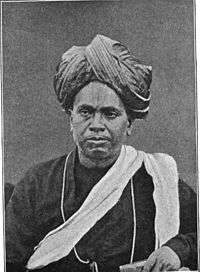C. V. Rungacharlu
Chettipunyam Veeravalli Rungacharlu CIE (c. August 1831 - d. 20 January 1883), also spelt as Rangacharlu, was an Indian civil servant and administrator who served as the Diwan of Mysore kingdom from 1881 to 1883. He was the first Diwan of Mysore following the restoration of monarchy in which Maharaja Chamaraja X promised to follow modern system of administration.
Sir Chettipunyam Veeravalli Rungacharlu | |
|---|---|
 | |
| 14th Diwan of the Mysore kingdom | |
| In office 1881–1883 | |
| Monarch | Chamaraja Wodeyar |
| Preceded by | Long vacant (after Arunachala Mudaliar's term in 1866) |
| Succeeded by | Sir K. Seshadri Iyer |
| Personal details | |
| Born | August 1831 Chingleput district, Madras Presidency, British India |
| Died | 20 January 1883 Madras, British India |
| Profession | administrator |
Early life
Rungacharlu was born in the Chingleput district, Madras Presidency in a Vadagalai Iyengar family.[1] His father C. Raghavachariar was a clerk in the Chingleput Collectorate. Rungacharlu's parents were poor and only after V. Raghavachariar, the first Indian magistrate in Madras promised to support him financially, that Rungacharlu was able to pursue his schooling to Madras. As a child, Rungacharlu developed a passion for chess.
Rungacharlu had his schooling at Pachaiyappa's School and the Madras High School passing his proficient's test in 1849 in first class. Immediately upon matriculating, Mr. Ellis appointed Rungacharlu as a clerk in the Madras Collectorate.
Early career
Rungacharlu began his career as an acting clerk in the Madras Collectorate. On confirmation, he was transferred to the Chingleput Collectorate and was soon promoted to Head Writer and put up in Salem. Rungacharlu performed well as a Head Writer and published two pamphlets - "Bribery and Corruption in the Revenue Department" and "Mirasi Rights in the Chingleput and Tanjore Districts". Soon, he was appointed Tahsildar of Saidapet and then, Head Sheristadar of Nellore. In 1859, he was appointed Special Assistant to G. N. Taylor, President of the Imam Commission. When the Imam Commission came to an end, Rungacharlu was appointed to the inquire into the working of the Indian Railways. Rungacharlu's performance in the commission won him rich accolades and when he returned to Madras, Rungacharlu was appointed Commissioner of the Madras Railway Company. He was serving as the Treasury Deputy Collector at Calicut in 1868, when he was invited to join the Mysore civil service.
In the Mysore service
Rungacharlu moved to Mysore in 1868 to take over as the Comptroller of the Mysore palace. As Comptroller, he wrote a pamphlet titled "The British Administration of Mysore" which was published in London in 1874. Soon afterwards, Mr. Gordon, the Commissioner of Mysore appointed Rungacharlu as his Revenue Secretary. As Revenue Secretary, Rungacharlu revamped the entire team of Commissioners and Deputy Commissioners substituted efficient Indians on moderate pay for inefficient Europeans drawing high salaries. As a result, the expenditure for his first year of service 1879-80 was reduced by rupees one and half lakhs. In appreciation of his services, Rungacharlu was made a Companion of the Order of the Indian Empire in the year 1880.
At about this time, an inquiry was launched into the disappearance of certain jewels from royal household when Rungacharlu was the Palace Comptroller. After a detailed enquiry, the disappearance of the jewels was attributed to a clerical error and Rungacharlu was absolved of all the accusations. Rungacharlu was eventually appointed Diwan of Mysore on 25 March 1881.
Diwan of Mysore
When Rungacharlu took over as Diwan in March 1881, Mysore was faced with a poor financial, agricultural and industrial condition. The state was devastated by the famine of 1877 and faced with a debt of eight lakh rupees.
Soon after Rungacharlu took over as Diwan, he disbanded Hassan and Chitradurga districts and downgraded nine taluks into Deputy Amildar sections. The number of Munsiff Courts, Sub-Courts and district jails were also reduced. These measures caused a drastic reduction in the expenses of the state. Rungacharlu also lifted the ban of the sale of sandalwood and sandalwood products. With the revenue generated by the sale of sandalwood, Rungacharlu developed an elaborate railway system for the princely state. He constructed a railway line from Bangalore to Tiptur and established a legislative assembly for the state.
Death
Rungacharlu fell seriously ill at the end of 1882. When the illness became critical, Rungacharlu resigned as Diwan. He was moved to Madras where he died on 20 January 1883.
Notes
- Jogendra Nath Bhattacharya (1896). Hindu Castes and Sects: An Exposition on the Origins of Hindu caste system. Thacker, Spink & Co. pp. 78.
References
- Mysore Gazetteer. pp. 3156–3157.
- Govinda Parameswaran Pillai (1897). Representative Indians. Routledge. pp. 129–142.
Other biographies
- Royaloo Chetty, T. (1909). A Brief Sketch of the Life of T. R. A. Thumboo Chetty, C.I.E, Formerly Chief Judge and Officiating Dewan of Mysore. Hoe & Co.Madras.
- D V Gundappa (1911). Diwan Rangacharlu.
- N. S. Chandrasekhara (1968). Dewan Rangacharlu: Builders of modern India. Publications Division, Ministry of Information and Broadcasting, Govt. of India.